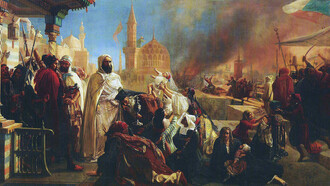The practice of cannibalism is the major offence against humanity, and in the past the European civilized societies used it as a convenient justification for colonizing indigenous people.
Today October 12th, 2019 is the anniversary of the discovery of America. 527 years have passed since Colombo’s arrival. Many years, but it is never enough to reflect on the Euro-Amerindian conflicted contact initiated by the Columbian enterprise. One positive outcome of this commemorative event is the attempt by some historians and scientific scholars to "rediscover" the nature and devastating consequences of a cultural contact that resonates in our own time. Of particular importance is whether this attempt has helped or not to exceed the Wild Savage and Noble Savage stereotypes associated with indigenous people. Unfortunately, attempts to set the record straight on this score have been fraught with the unscientific tendency of tipping the scales in favor of the Noble Savage stereotype.
This point is the long-standing controversy surrounding Amerindian anthropophagy or cannibalism; that is, the consumption of tissue belonging to an individual of the same species. Noting the potential for cultural relativity, "cannibalism can include drinking water-diluted ashes of a cremated relative, licking blood off a sword in warfare, celebrating Christian communion, or gnawing on entire barbecued limbs as the engraver Theodor de Bry (1528-1598), famous for his depictions of European expedition to the Americas by the European, depicts Caribs doing.
Perhaps it is inevitable that cannibalism, which entered the European vocabulary from Columbus's diary accounts of the Caribs, surfaces like an old chestnut in recent scholarly examinations of the first years of Euro-Amerindian contact. In early modern treatises, ethnographies and depictions, the practice is cited as one of the Amerindians' major offences against humanity. Amerindian cannibalism is dismissed as a "myth" perpetrated by colonizers and their apologists in order to justify enslavement and genocide. While recent critiques are right in censuring early modern Eurocentric and often racist accounts of Amerindian societies, they too engage in "public relations" when they deny or explain away the existence of cannibalism. In a kind of inscription of the Noble Savage stereotype, there is perhaps a mistaken belief that cannibalism makes less credible or worthy Amerindians' claims for self-determination and social justice.
One of the principle authorities used in denying the existence of cannibalism was the anthropologist William Arens (see his book The man eating myth). More recent commentators, however, have failed to mention that Arens has been roundly and substantially contradicted by numerous scholars, perhaps most significantly by Arens himself who, while deploring the standard of anthropological evidence on the existence of cannibalism, is careful to add that his critiques "obviously do not prove" that certain Amerindian groups were not cannibals. Yet Arens continues to be approvingly cited as an authority for denying the existence of a phenomenon that has been amply documented by anthropologists and archeologists alike. At the root of this denial seems to be an ethnocentric evaluation of cannibalism as a taboo both in terms of its historic practice and its complexity as a discursive strategy in analyzing the devastating and enduring consequences of early modern Euro-Amerindian contact.
It is a complex discourse because clearly cannibalism and its attendant stereotypic image of the Wild Savage were indeed used to justify ill treatment toward indigenous people. This, however, in no way justifies denying the existence of the phenomenon. George Sioui, a historian and Hurons-Wendat of Quebec (one of the first Amerindian nations), notes that "the notion of cannibalism as practised by 'primitive' cultures is a product of the racist thinking of so-called civilized societies." Sioui goes on to assert: "One fact is certain, however, and it deserves the greatest respect; Amerindians did sometimes consume one or several parts (for example the heart) of the body of a prisoner who died a particularly courageous death."
Cannibalism, albeit only a small aspect of some early modern Amerindian societies, has been at the obscure centre of cultural stereotyping for at least half a millenium. It has been used as a convenient justification for colonizers' "just wars" against indigenous peoples, and now it has become an inconvenient "myth" that modern commentators seek to deny or explain away. The two responses may seem different but they are really two sides of a dangerous dualism that keeps alive the Wild Savage-Noble Savage stereotype of indigenous peoples.















